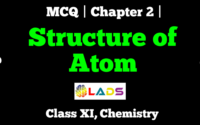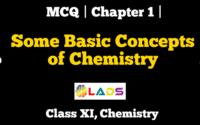MCQ of Redox Reactions | Chapter 8 | Chemistry | Class 11 | CBSE |
MCQ of Redox Reactions, Chapter 8, Chemistry, Class 11
Question 1: Which of the following statement is not true?
- In a chemical reaction, oxidation is always accompanied by reduction
- When a negative ion changes to neutral species, the process is oxidation
- Oxidising agent has a tendency to loose electrons.
- Conversion of MnO42- to MnO4¯ is oxidation
Answer: C ( Oxidising agent has a tendency to lose electrons )
Question 2: Which of the following is not a rule for calculating oxidation number?
- For ions, oxidation number is equal to the charge on the ions
- The oxidation number of oxygen is -2 in all of its compounds
- The oxidation number of fluorine is -1 in all of its compounds
- Oxidation number of hydrogen is +1 except in binary hydrides of alkali metals and alkaline earth metals where it is -1.
Answer: B ( The oxidation number of oxygen is -2 in all of its compounds )
Question 3: Oxidation number of carbon in CH2Cl2 is
- 0
- +1
- +2
- +4
Answer: A (0)
Question 4: The oxidation state of iron in Fe (CO)4 is
- +1
- –1
- +2
- 0
Answer: D (0)
Question 5: Carbon is in lowest oxidation state in
- CH4
- CCl4
- CF4
- CO2
Answer: A (CH4)
Question 6: The element that does not show positive oxidation state is
- O
- N
- Cl
- F
Answer: D (F)
Question 7: The oxidation number of an element in a compound is evaluated on the basis of certain rules. Which of the following rules is not correct in this respect?
- The oxidation number of hydrogen is + 1.
- The algebraic sum of all the oxidation numbers in a compound is zero.
- An element in the free or the uncombined oxidation state bears oxidation number zero.
- In all its compounds, the oxidation number of fluorine is -1.
Answer: A ( The oxidation number of hydrogen is + 1 )
Question 8: Mark the correct statement from the following.
- Copper metal can be oxidised by Zn2+
- Oxidation number of phosphorous is P4
- An element in the highest oxidation state acts as a reducing agent
- The element which shows highest oxidation number of +8 is Os in OsO4
Answer: A ( Copper metal can be oxidised by Zn2+ )
Question 9: Which compound among the following has lowest oxidation number of chlorine?
- HClO4
- HClO3
- HCl
- HOCl
Answer: C (HCl)
Question 10: When a piece of sodium metal is dropped in water, hydrogen gas is evolved because
- Sodium is reduced and acts as an oxidising agent
- Water is oxidised and acts as a reducing agent
- Sodium loses electrons and is oxidised while water is reduced
- Water loses electrons and is oxidised to hydrogen
Answer: C ( Sodium loses electrons and is oxidised while water is reduced )
You may also read MCQ of Basic Concepts of Chemistry, MCQ of Structure of Atom, MCQ of Classification of Elements and Periodicity in Properties, MCQ of Chemical Bonding and Molecular Structure, MCQ of States of Matter, MCQ of Hydrogen, MCQ of Organic Chemistry; Some Basic Principles and Techniques for better understanding of the chapters.
Question 11: What is the oxidation state of P in Ba(H2PO2)2 ?
- +3
- +2
- +1
- -1
Answer: C (+1)
Question 12: Given below is a redox reaction. Which of the following types the reaction belongs to?
CuSO4 + Zn → Cu + ZnSO4
- Combination reaction
- Decomposition reaction
- Metal displacement reaction
- Non metal displacement reaction
Answer: C (Metal displacement reaction)
Question 13: Identify the correct statement with respect to following reactions: 2 K2MnO4 + Cl2 → 2KCl + 2KMnO4
- Oxidation of potassium manganate is taking place
- Reduction of potassium manganate is taking place
- Oxidation of Cl2 is taking place
- Cl2 acts as reducing agent in the reaction
Answer: A ( Oxidation of potassium manganate is taking place )
Question 14: Which of the following statement is correct regarding redox reactions?
- An increase in oxidation number of an element is called reduction
- A decrease in oxidation number of an element is called oxidation
- A reagent which lowers the oxidation number of an element in a given substance is reductant
- A reagent which increases the oxidation number of an element in a given substance is reductant
Answer: C ( A reagent which lowers the oxidation number of an element in a given substance is reductant )
Question 15: Li occupies higher position in the electrochemical series of a metal as compared to Cu since
- The standard reduction potential of Li+/Li is lower than Cu2+ / Cu
- The standard reduction potential of Cu2+ / Cu is lower than Li+/Li
- The standard oxidation potential of Li / Li+ is lower than Cu / Cu2+
- Li is smaller in size as compared to Cu
Answer: A ( The standard reduction potential of Li+/Li is lower than Cu2+ / Cu )
Question 16: Given below are few statements regarding electrode potentials. Mark the correct statement
(i) The potential associated with each electrode is known as electrode potential.
(ii) A negative E° means that the redox couple is a stronger reducing agent than H+ / H2 couple.
(iii) A positive E° means that the redox couple is a weaker reducing agent than H+ / H2 couple.
- (i) and (ii)
- (i) and (iii)
- (ii) and (iii)
- (i), (ii) and (iii)
Answer: D ( (i), (ii) and (iii) )
Question 17: Which of the following is not a correct statement about electro-chemical series of reduction potential?
- The standard electrode potential of hydrogen is 0.00 volts.
- Active non metals have positive reduction potential
- Active metals have negative reduction potential
- Metals which have positive reduction potentials are good reducing agent
Answer: D ( Metals which have positive reduction potentials are good reducing agent )
Question 18: Fluorine is a best oxidising agent because
- It is most electronegative
- It has smallest reduction potential
- It has highest oxidation potential
- It has smallest size
Answer: B ( It has smallest reduction potential )
Question 19: If a spoon of copper metal is placed in a solution of FeSO4, what will be the correct observation?
- Copper is dissolved in FeSO4 to give brown deposit
- No reaction takes place
- Iron is deposited on copper spoon
- Both copper and iron are precipitated
Answer: B (No reaction takes place)
Question 20: Which will occur if a block of copper metal is dropped into a beaker containing a solution of 1 M ZnSO4?
- The copper metal will dissolve with evolution of oxygen gas
- The copper metal will dissolve with evolution of hydrogen gas
- No reaction will occur
- The copper metal will dissolve and zinc metal will be deposited
Answer: C (No reaction will occur)
Question 21: The E° values of redox complex of halogens are given. Based on these values mark the correct statement .
E°I2/I¯ = + 0.54 V, E°Br2/Br¯ = + 1.08 V, E°Cl2/Cl¯ = + 1.36 V
- Chlorine can displace bromine and iodine from their salt solutions
- Chlorine can only displace iodine from its salt solution
- Bromine can displace chlorine from its salt solution
- Iodine can displace chlorine and bromine from their salt solutions
Answer: A ( Chlorine can displace bromine and iodine from their salt solutions )
Question 22: A metal X displaces nickel from nickel sulphate solution but does not displace manganese from manganese sulphate solution. What is the correct order of their reducing powers?
- Ni > Mn > X
- X > Mn > Ni
- Mn > X > Ni
- Mn > Ni > X
Answer: C (Mn > X > Ni)
Question 23: In which of the following an element exhibits two different oxidation states?
- NH2OH
- NH4NO3
- N2H4
- N3H
Answer: B (NH4NO3)
Question 24: Which of the following colour changes shown during redox titration is not correct?
- Cr2O72- oxidises the indicator diphenylamine to produce blue colour showing end point
- Iodine formed by oxidation of I¯ ions give blue colour with starch showing end point
- KMnO4 in the form of MnO4¯ ions gives pink colour showing end point
- Thiosulphate ions give blue colour showing end point
Answer: D ( Thiosulphate ions give blue colour showing end point )
Question 25: What will be the order of decreasing reducing nature for the given metals?
- Zn > Na > Fe > Mg > Cu > Ag
- Cu > Fe > Mg > Zn > Na > Ag
- Ag > Cu > Fe > Zn > Mg > Na
- Na > Mg > Zn > Fe > Cu > Ag
Answer: D (Na > Mg > Zn > Fe > Cu > Ag)
Question 26: A metal X displaces nickel from nickel sulphate solution but does not displace manganese from manganese sulphate solution. What is the correct order of their reducing powers?
- Ni > Mn > X
- X > Mn > Ni
- Mn > X > Ni
- Mn > Ni > X
Answer: C (Mn > X > Ni)
Related
Do share the post if you liked the MCQ of Redox Reactions. For more updates, keep logging on BrainyLads



